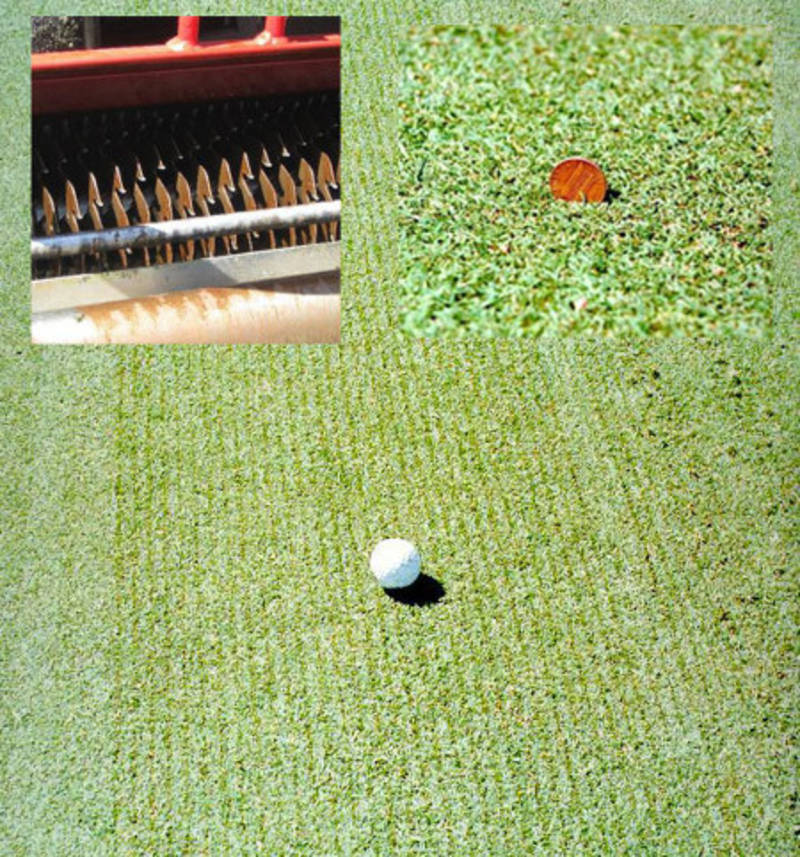 |
| Fig A. |
Why are golf greens verticutt so often?
What if your St. Augustine grass was verticutt more often?
|
 |
| Fig b. Does your lawn look like this? |
- Let's discuss the question of why not verticutt more often? Ok, your lawn is not a golf green, but why is it different? The biggest reason St. Augustine grasses continue to grow on top of itself, called layering. Creating thatch, and difficult mowing conditions.
Golf greens are built on special soil structures, The
additional traffic then creates compacting of the soil.
Making aeration and verticutting so necessary to the health of the green.

The layering or matting is created by overwatering, too much fertilizer, mowing too high, and not verticutting. All these factors create thatch, not grass clippings.
2. Aeration versus Verticutting for St. Augustine grasses, in central and South Florida?
- The truth, some dishonest companies are pushing aerating, Why?
- It's easy money.
- Aeration will have no effect on St. Augustine lawns grown on sand.
- The aerator drops the core back on the lawn, so any thatch it removes is left.
- Then because it's sand what keeps the hole from filling back up?
- Also, aeration has no effect layering.
- Moving north from Tampa bay, the soil structures will change, and then the lawns may require aeration.
Does your lawn need verticutting? Contact York for a free estimate:
york.ysta@gmail.com or 727-455-7337
Cutting Up
There is a missing link in many lawn care programs — an underutilized cultural practice that boosts turf health and, potentially, your bottom line. Vertical mowing is a healthy habit and a beneficial component of an annual turf care routine. Simply put, vertical mowing encourages turf to take its vitamins.
The practice turns up thatch and opens the turf canopy so it can drink up nutrients and water, and clear out room for fresh growth. Verticutting is an energy boost, setting the stage for green-up in spring and preparing turf for overseeding in fall. And most turf varieties appreciate verticutting — the vigorous mowing isn't limited to sports turf or commercial properties.
Consider verticutting part of a balanced diet. Here are some ways to make sure your turf receives the correct dose and some details on choosing appropriate equipment to deliver the best results.
DIGGING IN
Verticutting is a deep-cleaning process for the turf canopy. Vertical blades — arranged .025 to 1.5 inches apart on a disc — ( (spacing for St. Augustine 3-4" apart) rotate through turf, dredging up thatch and opening the canopy to allow the turf to breath. Vertical mowing in the traditional sense is a remedial mechanical process to remove excess thatch, reduce turf canopy density and extract organic material from the turf region at or below the plant crown area. Verticutting isn't aeration, and it isn't grooming. But often, there is a mix-up between the two.
Golf course superintendents who groom turf understand the regenerative benefits of conditioning their turf. Though the concept is similar to verticutting, the results are quite different. Groomers are a lightweight version of a verticutter. The vertical blades are thinner and the cutting depth is less — targeting the growing points and tips of the grass stem. Results from groomers are less drastic, allowing turf to recover quickly and look relatively untouched.
Verticutters, on the other hand, dig deeper into the turf canopy and penetrate the crown area of the plant, possibly below, severing stolons and stems. While groomers are designed to condition or stimulate new growth, verticutters are more rigorous and remove thatch. When a verticutter passes over a section of turf, results are visible. Vertical mowing can be disruptive if you cut deeply into the canopy. Upturned soil and debris rest on the turf surface.
Cleanup is simple, requiring one pass over the area with a mower to collect residual debris. This step is critical to ensure what's left behind doesn't compact into soil and reverse verticutting benefits. Removing debris and opening the turf canopy also reduces humidity, promotes drying and reduces the opportunity for disease development.
Sure, verticutting can be dirty work. But the benefits are worth the cleanup — and recovery is minimal if you perform the process properly, gauge verticutting vigor based on turf requirements and utilize the right equipment for the job. Light vertical mowing (being less aggressive and more frequent), can benefit both active growing and aggressive turf by promoting superior turf performance and persistence.

No comments:
Post a Comment